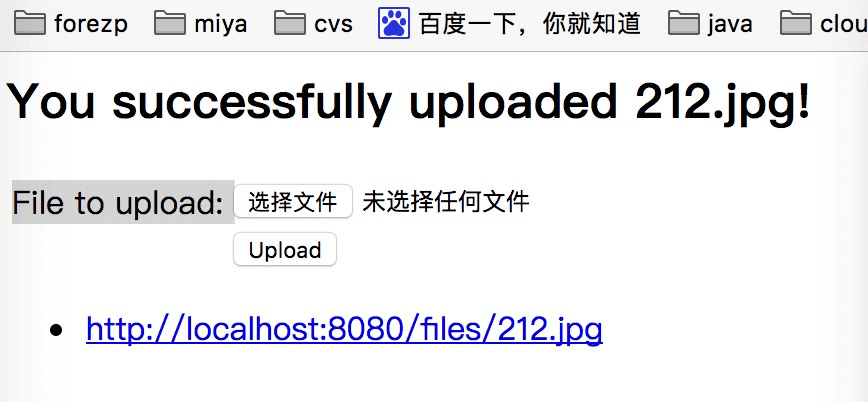编程语言
308
这篇文章主要介绍,如何在springboot工程作为服务器,去接收通过http 上传的multi-file的文件。
构建工程
为例创建一个springmvc工程你需要spring-boot-starter-thymeleaf和 spring-boot-starter-web的起步依赖。为例能够上传文件在服务器,你需要在web.xml中加入标签做相关的配置,但在sringboot 工程中,它已经为你自动做了,所以不需要你做任何的配置。
<dependencies> <dependency> <groupId>org.springframework.boot</groupId> <artifactId>spring-boot-starter-web</artifactId> </dependency> <dependency> <groupId>org.springframework.boot</groupId> <artifactId>spring-boot-starter-test</artifactId> <scope>test</scope> </dependency> <dependency> <groupId>org.springframework.boot</groupId> <artifactId>spring-boot-starter-thymeleaf</artifactId> </dependency> </dependencies>
创建文件上传controller
直接贴代码:
@Controller public class FileUploadController { private final StorageService storageService; @Autowired public FileUploadController(StorageService storageService) { this.storageService = storageService; } @GetMapping("/") public String listUploadedFiles(Model model) throws IOException { model.addAttribute("files", storageService .loadAll() .map(path -> MvcUriComponentsBuilder .fromMethodName(FileUploadController.class, "serveFile", path.getFileName().toString()) .build().toString()) .collect(Collectors.toList())); return "uploadForm"; } @GetMapping("/files/{filename:.+}") @ResponseBody public ResponseEntity<Resource> serveFile(@PathVariable String filename) { Resource file = storageService.loadAsResource(filename); return ResponseEntity .ok() .header(HttpHeaders.CONTENT_DISPOSITION, "attachment; filename=\""+file.getFilename()+"\"") .body(file); } @PostMapping("/") public String handleFileUpload(@RequestParam("file") MultipartFile file, RedirectAttributes redirectAttributes) { storageService.store(file); redirectAttributes.addFlashAttribute("message", "You successfully uploaded " + file.getOriginalFilename() + "!"); return "redirect:/"; } @ExceptionHandler(StorageFileNotFoundException.class) public ResponseEntity handleStorageFileNotFound(StorageFileNotFoundException exc) { return ResponseEntity.notFound().build(); } }
这个类通过@Controller注解,表明自己上一个Spring mvc的c。每个方法通过 @GetMapping 或者@PostMapping注解表明自己的 http方法。
- GET / 获取已经上传的文件列表
- GET /files/{filename} 下载已经存在于服务器的文件
- POST / 上传文件给服务器
创建一个简单的 html模板
为了展示上传文件的过程,我们做一个界面: 在src/main/resources/templates/uploadForm.html
<html xmlns:th="http://www.thymeleaf.org"> <body> <div th:if="${message}"> <h2 th:text="${message}"/> </div> <div> <form method="POST" enctype="multipart/form-data" action="/"> <table> <tr><td>File to upload:</td><td><input type="file" name="file" /></td></tr> <tr><td></td><td><input type="submit" value="Upload" /></td></tr> </table> </form> </div> <div> <ul> <li th:each="file : ${files}"> <a th:href="${file}" th:text="${file}" /> </li> </ul> </div> </body> </html>
上传文件大小限制
如果需要限制上传文件的大小也很简单,只需要在springboot 工程的src/main/resources/application.properties 加入以下:
spring.http.multipart.max-file-size=128KB spring.http.multipart.max-request-size=128KB
测试
测试情况如图:

参考资料
https://spring.io/guides/gs/uploading-files/
源码下载
广告











